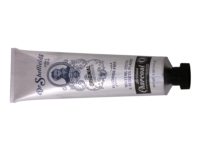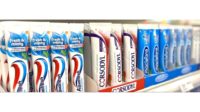Colgate Launches Recyclable Toothpaste Tube with "Recycle Me!" Packaging in the U.S.

Colgate "Recycle Me!" Limited Edition packaging.
Image courtesy of Colgate-Palmolive
Colgate-Palmolive's tube, the first to be recognized by external recycling authorities as recyclable, is made from High Density Polyethylene (HDPE), the same No. 2 plastic used for milk and detergent bottles. Recycling the tube alongside plastic bottles requires no extra steps -- no rinsing, cutting or cleaning before tossing it into a recycling bin.
But making a toothpaste tube that is recyclable is only half the battle. Traditionally, since most of the world's toothpaste tubes are made with a mix of materials, they have not been recycled. Globally, that adds up to 20 billion toothpaste tubes a year that get tossed in the trash.
To alert shoppers that the Colgate tube is now recyclable, Colgate is bringing it out in a "Recycle Me!" tube. The bold, limited edition graphics will be found on select tubes of Colgate Optic White Advanced Sparkling White, Colgate Cavity Protection, Colgate Max Fresh Cool, and Colgate Total Whitening, with the transition of the rest of the Colgate toothpaste line to be completed by 2023.
The goal of "Recycle Me!" is to build awareness of recyclable tubes not only among consumers, but also the operators of the Materials Recovery Facilities (MRFs) that sort plastic, reprocessors that make resin from recycled plastic, and other recycling stakeholders.
"As the global toothpaste leader with a brand found in more homes than any other, we want to lead in waste reduction and, in particular, making toothpaste tubes a part of the circular economy. The Recycle Me! tube is designed to educate and engage consumers and the recycling community who are both essential to progress, and we are excited to initiate and learn from our upcoming pilot program," said Dana Medema, Vice President & General Manager, Oral Care for Colgate-Palmolive in North America.
Colgate-Palmolive is developing a recyclable tube pilot program in partnership with peer companies and working with a leading MRF and reprocessor in the U.S. The pilot will focus on one county or municipality to test how educational efforts can build tube recycling rates and assess the quality of the tube material that is collected for reprocessing. The data will be used to define easy-to-action best practices for tube recycling to be shared with communities and recyclers around the country.
Colgate-Palmolive has taken other important actions to build momentum for the adoption and acceptance of recyclable tubes.
One was to use HDPE. Colgate chose it because the HDPE bottle stream has one of the highest recycling rates, at about 30% in the U.S. It wasn't easy to work with; HDPE is rigid and not well suited for squeezable tubes. But by combining different layers of HDPE laminate at varying thicknesses, Colgate engineers were able to produce a soft, easy-to-squeeze recyclable tube that will also protect the product across roughly 150 brushing occasions during the life of a typical 6 oz. tube.
The other was to share its recyclable tube know-how with other companies, including competitors, through some 50 packaging forums and 1-on-1 meetings to promote the transition to recyclable tubes. For recyclable tubes to be a success, it requires a critical mass of tubes on shelf that meet recycling standards. That will encourage the recycling community to add tubes to their lists of acceptable materials and support a new habit among consumers to recycle tubes.
Momentum is building. Major toothpaste brands, which with Colgate account for 90% of the US market, have publicly committed to switching to recyclable HDPE toothpaste tubes by 2025. During this transition phase, acceptance of tubes at certain recycling facilities may be limited, and consumers should check with their local community facilities.
Looking for a reprint of this article?
From high-res PDFs to custom plaques, order your copy today!






.jpg?height=200&t=1652126480&width=200)